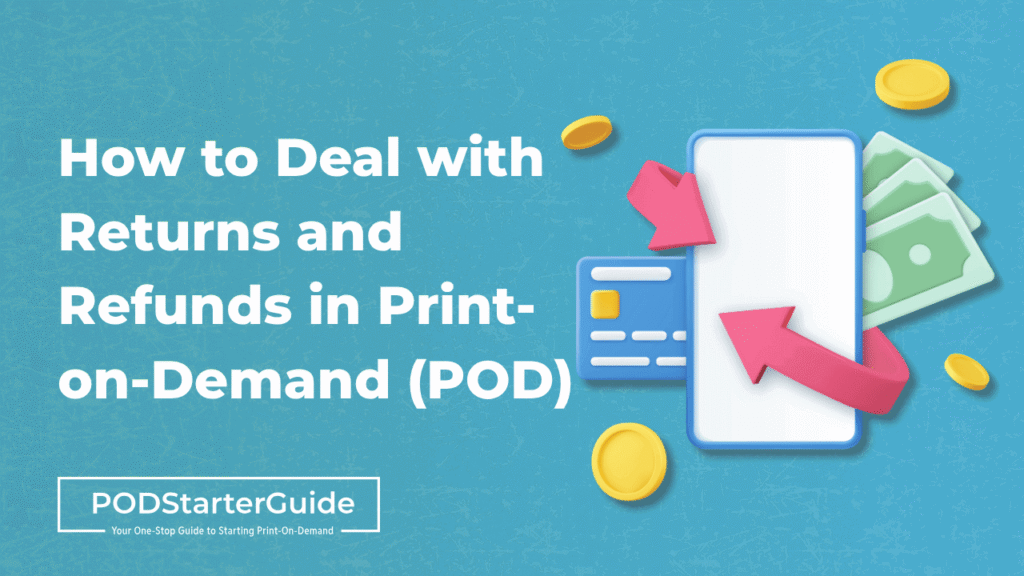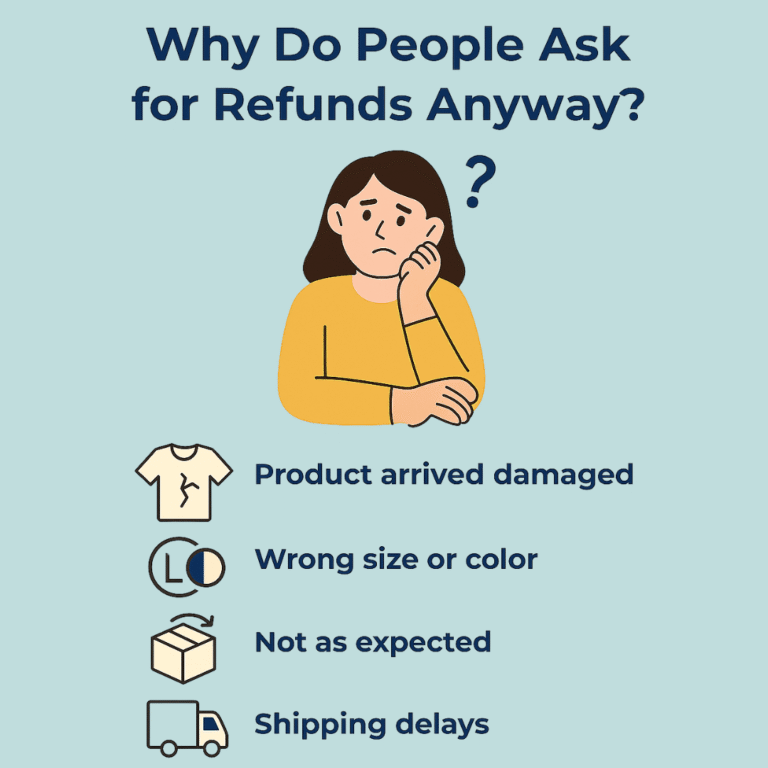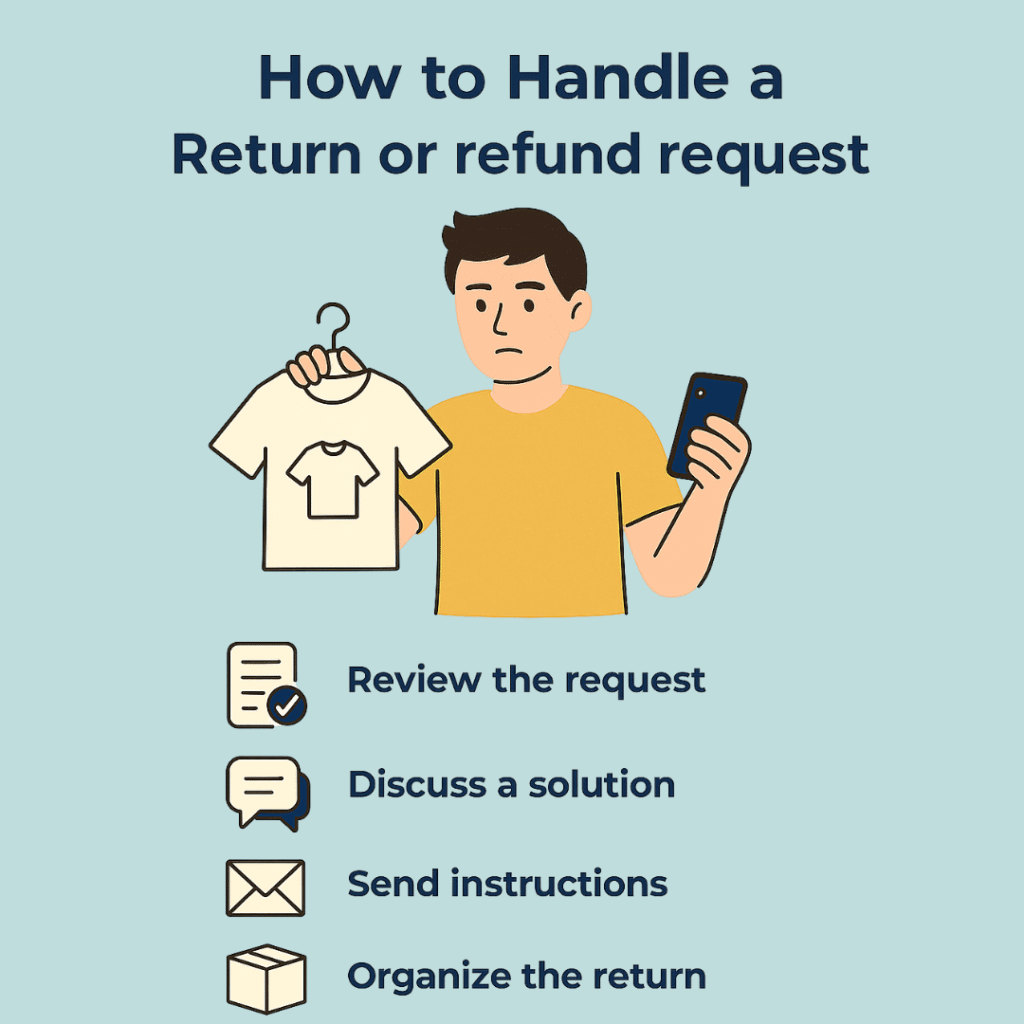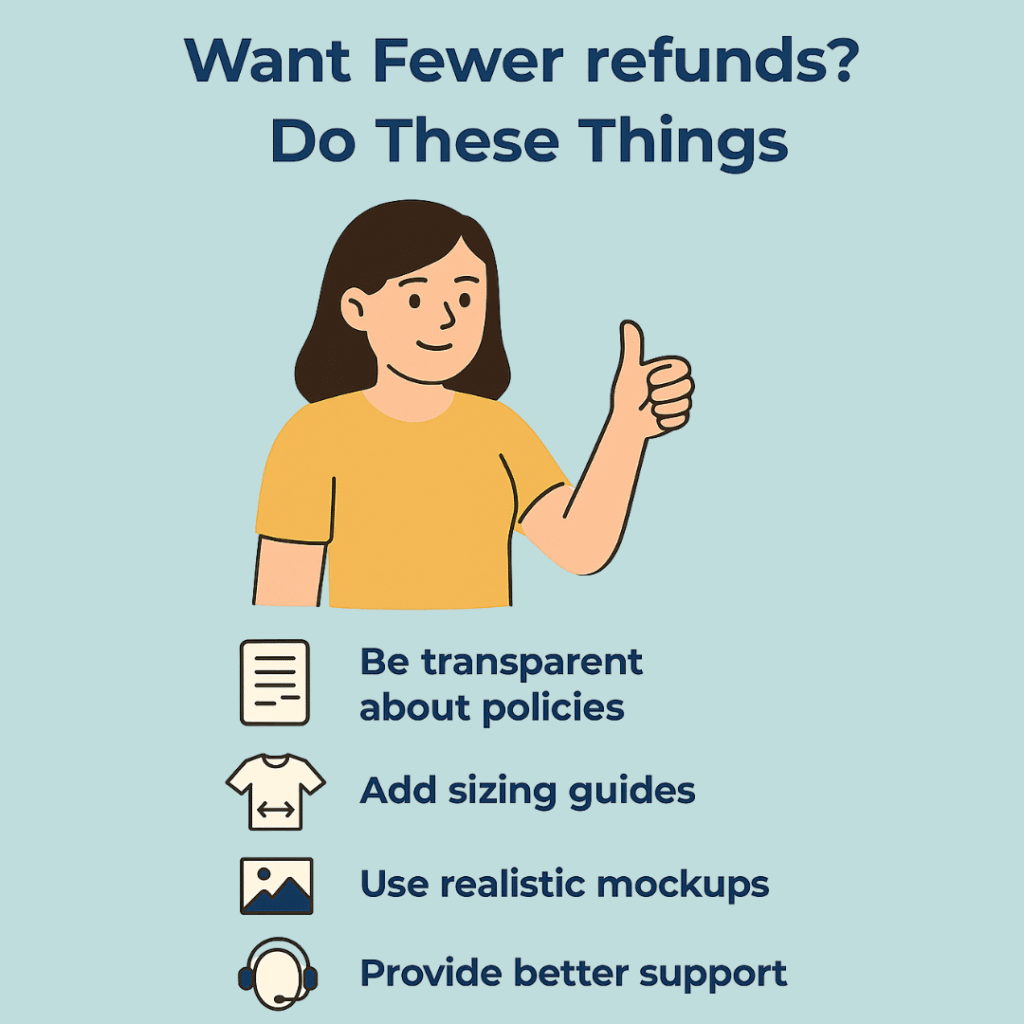How to Deal with Returns and Refunds in Print-on-Demand (POD): A Complete Guide for Sellers

In the Print-on-Demand (POD) world, returns and refunds are the kind of thing no one really wants to talk about—but you kind of have to. Whether you’re running a full-blown store or testing a niche with a few designs, at some point, a customer will reach out and say those dreaded words: “I want a refund.”
So… how do you actually deal with returns and refunds in Print-on-Demand (POD)? This guide breaks it down in a simple way.
What Makes POD Returns a Bit Tricky?
Selling custom-printed products sounds super chill, right? Just design, upload, and boom—money rolls in. But here’s the twist: you’re not printing, packing, or shipping anything yourself. It’s all happening through a third-party supplier behind the scenes.
And that makes handling returns a bit of a maze.
- You don’t have control over the product quality once it leaves the factory.
- You can’t just “take back” a t-shirt and resell it—it’s custom-made for that buyer.
- The product is usually one-of-a-kind, with no resale value.
- There’s often a delay in communication—you need to contact the POD supplier, who may be dealing with multiple sellers.
- Shipping issues? You don’t control the courier either.
- Inconsistent print results happen—colors may vary slightly, and mockups don’t always match reality.
- Some platforms don’t offer a return at all, unless there’s a clear defect.
- And if the issue’s unclear? You end up stuck between an angry customer and a supplier who won’t take blame.
These tiny (and not-so-tiny) things pile up fast. Suddenly, dealing with a simple return in POD feels like solving a Rubik’s cube with one hand tied behind your back—blindfolded.
Also read: Pros and Cons of Print on Demand: Is it the Right Business Model for You?
Why Do People Ask for Refunds Anyway?

Not all returns are the customer’s fault. And not all are your supplier’s either. Here’s what usually goes wrong:
- Product arrived damaged – maybe the print was smudged, or the mug broke during shipping.
- Wrong size or color – even though the sizing chart was there, people mess up.
- Not as expected – maybe the mockup looked brighter, or the font looked bigger online.
- Shipping delays – longer than promised deliveries can be frustrating.
- Customer simply changed their mind – rare, but it happens.
Important side note? Most POD platforms don’t accept returns if the customer just doesn’t want the product anymore. So setting boundaries is key.
You Need a Returns & Refund Policy (Don’t Skip This)
Before orders even start rolling in, set up a crystal-clear return policy. Like seriously, write it down, put it on your website, and make it easy to find. This saves time, trust issues, and a bunch of back-and-forth emails later.
What should it include?
- Which items are eligible (damaged, defective, wrong item, etc.)
- Timeframe (ex: within 7 or 14 days of delivery)
- Proof requirement (photos of the issue)
- Return shipping terms – who pays?
- Non-returnable situations (buyer’s remorse, custom personalization)
Having these upfront builds trust and makes it easier when you do need to handle returns and refunds in Print-on-Demand (POD).
How to Handle a Return or Refund Request (Step-by-Step)

Now let’s say someone does message you. What next? Here’s how to deal with it without panicking:
- Acknowledge quickly. Even if you’re waiting on info from your supplier, reply within 24 hours. It helps keep the customer calm.
- Request details. Ask for the order ID, a description of the issue, and photos.
- Talk to your POD supplier. Whether it’s Printful, Printify, or someone else, raise a claim with them using the proof.
- Choose how to resolve. Depending on what went wrong:
- Offer a replacement
- Send a refund
- Politely deny if it’s outside your policy
- Follow up. Once resolved, drop a quick follow-up message to make sure they’re happy—or at least, not angry.
Yep, it’s a bit of a process. But with the right tone and approach, it can be pretty smooth.
Working With Your POD Platform Makes All the Difference
Each POD platform has its own return/refund policies—and they’re not always in your favor.
Here’s a quick glance:
- Printful – They usually handle defective or damaged goods, no problem. But they won’t refund for buyer’s remorse. Click here to check Printful Return Policy
- Printify – Works more like a middleman. You’ll need to reach out and provide solid proof. Click here to check Printify Return Policy
- Teespring / Spring – A bit more customer-focused. Easier to process returns in some cases. Click here to check Spring Return Policy
Tip: Bookmark your supplier’s return policy. Reference it often. Also, create a cheat sheet of how each platform handles refunds. It’ll save you hours.
Want Fewer Refunds? Do These Things

Honestly, the best way to deal with returns and refunds in Print-on-Demand (POD)… is to avoid them in the first place.
Here’s how:
- Use realistic mockups. Fancy photos are fun, but keep them accurate.
- Provide detailed size charts. And maybe throw in a guide on how to measure.
- Be clear with product descriptions. Texture, fit, care instructions—all of it.
- Communicate early. Late delivery? Let them know before they ask.
- Ask for feedback. It helps you improve and shows you care.
It’s these little proactive steps that lead to happy customers—and fewer complaints.
What About the Legal Stuff?
If you’re selling internationally, or even just in India or the US, be aware: different countries have different return laws. Some require sellers to offer a return window by law. Others protect you, the seller, from unfair refund demands.
- For example, EU laws are strict about customer rights.
- In India, consumer protection is evolving in the e-commerce space.
- U.S. laws vary by state, but generally lean more toward flexible store policies.
Bottom line? Be fair, be clear, and stay updated. You don’t want a legal headache over a $20 t-shirt.
Tools That Help Automate Returns
Manually tracking returns? It’s okay if you’re just starting out. But as you scale, you’ll want tools that streamline this whole circus. Here are a few worth checking out:
- AfterShip Returns Center – automates the process and tracks shipments
- Richpanel – a customer service platform with return handling
- Zendesk or Gorgias – if you’re handling a lot of support tickets
You don’t need all of them. Start simple. But automation can seriously reduce refund-related headaches.
Conclusion: How to Deal with Returns and Refunds in Print-on-Demand (POD)
Returns and refunds are just part of the game. Every Print-on-Demand seller faces them—no matter how awesome their designs are. What matters is how you handle them. Be responsive. Be fair. And above all, be clear. The better your communication, the smoother it all goes.
If you’re wondering how to deal with returns and refunds in Print-on-Demand (POD), remember—it’s not about avoiding them altogether (though that would be nice). It’s about setting up a system, communicating openly, and constantly improving. The goal isn’t perfection—it’s progress.
Also read: A/B Testing in Print on Demand?: What to Test and Why It Matters
FAQ – Quick Answers to Common POD Return Questions
Yes, especially if your policy says custom items aren’t returnable. Just be polite and explain clearly.
First, confirm the tracking info from your POD supplier. If it shows delivered, ask the customer to check with neighbors or local post office. If it’s truly lost in transit, many POD companies (like Printful) will reprint and resend for free. Otherwise, you may have to cover the cost—or offer a discount as a gesture of goodwill.
In rare cases, you may have to eat the cost to keep your customer happy. It’s a business call.
Depends on where you’re selling. Check local e-commerce laws.
In most POD setups, no. Since items are custom-printed for each order, they aren’t usually returnable or resellable. The product doesn’t go back to the POD provider, and if you receive it, you’ll need to handle it yourself—with no resale guarantee.
If the product was made correctly, most POD companies won’t refund or replace it just because of buyer’s remorse. In such cases, it’s up to you to decide whether to offer a refund at your own cost or stick to your policy.
Technically yes—but you’ll be paying for it unless the POD company made a mistake. Size exchanges are not covered unless the wrong size was shipped by the supplier. Always highlight sizing charts to prevent this.